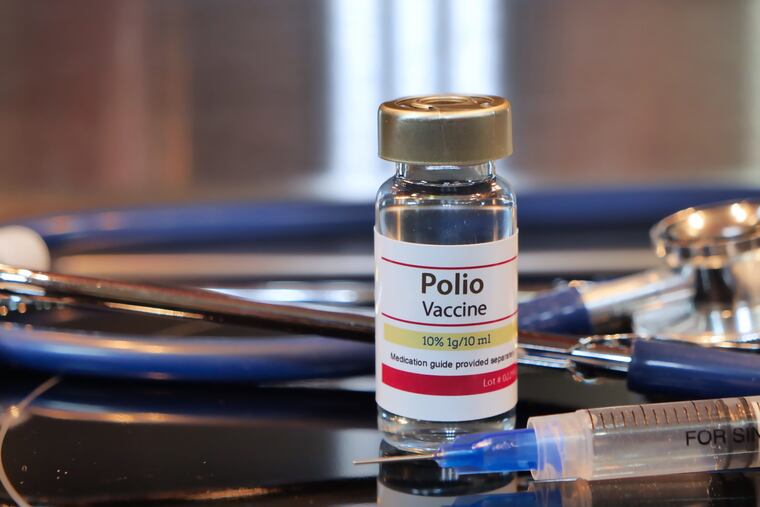Polio is likely circulating in Philadelphia. Here’s what you need to know.
The U.S. declared itself polio-free in 1979. So why is it back?

The stealthy polio virus is likely circulating undetected in Philadelphia, according to the city’s top health official.
“I do suspect that if we look,” Health Commissioner Cheryl Bettigole said in an interview earlier this month, “we might find it.”
In July, the United States reported its first polio case in nearly a decade. A young man from New York, who was unvaccinated and developed paralysis, tested positive for a strain of the virus that health officials believe mutated from a weakened live virus used in the oral vaccine.
» READ MORE: These Philadelphia-area polio survivors continue to suffer from a disease thought to be long gone
It’s still not clear exactly when or where the patient had contracted the disease, but subsequent wastewater testing found a similar strain in samples in New York. The Centers for Disease Control and Prevention cautioned that there have probably been asymptomatic or unidentified polio cases circulating in the state for months.
“This is a warning shot. It needs to be taken seriously,” said pediatrician Paul Offit, director of the Vaccine Education Center at Children’s Hospital of Philadelphia. “I suspect he won’t be the last case. This is not a disease you want to revisit.”
The United States declared itself polio-free in 1979. So why is it back? Here’s what you need to know:
Who’s at risk in Philadelphia?
Americans who are vaccinated are well-protected against polio. The polio vaccination rate in Philadelphia for children under 5 is 90% for the required four doses. However, in a few pockets of South Philadelphia, less than 60% of children have been vaccinated against polio, according to the city.
And that’s cause for concern, health experts say.
“If you’ve got polio in wastewater, there’s got to be a bunch of folks hanging around who have the polio virus in their intestines and are transmitting it — there’s community transmission, which scares the hell out of people and should,” said Richard Bruno, director of the New Jersey-based International Centre for Polio Education.
The CDC recommends children receive injections of the polio vaccine at 2 months, 4 months, between 6 and 18 months, and at 4 to 6 years old.
What’s the status of polio monitoring?
Public health agencies across the United States don’t routinely test wastewater for polio. Instead, health officials wait until someone infected with the virus turns up at a doctor’s office or hospital. By then, the virus is silently circulating. That’s what happened in New York after a young man in Rockland County sought treatment for polio-induced paralysis in June and subsequent wastewater testing found the virus in sewage samples in that county and three others, as well as in New York City.
Philadelphia currently tests wastewater only to find COVID-19. But Bettigole said she hopes to adapt the city’s testing program to proactively look for polio with the goal of getting ahead of potential spread in communities where people are unvaccinated or under-vaccinated. The virus, which reproduces in the intestines and sheds in stool, spreads through hand-to-mouth contact.
“One case of paralytic polio potentially indicates that there may be hundreds of other cases,” the city’s health department cautions.
If people are infected with polio, will they know it?
Most people infected with polio won’t know it.
Roughly 70% of those infected experience no symptoms but can infect others. Of those who do feel sick, the symptoms are mild, including fever, sore throat, fatigue, and an upset stomach. About 1 of every 200 cases will cause paralysis.
How long has polio been a health concern?
Polio is a centuries-old disease. Historians point to a stone slab from ancient Egypt that depicts a priest with telltale signs of paralysis — a withered leg and foot. But polio epidemics didn’t plague communities in the United States until the 1900s, when outbreaks sporadically surfaced across the nation, typically during warmer months.
There’s no settled science on why polio went from endemic — usually a mild, unremarkable disease akin to a cold or flu — to an epidemic, which peaked in the early 1950s, killing thousands of children and paralyzing many more. There are theories that better sanitation and hygiene in the late 1800s and early 1900s meant mothers were less likely to be exposed to the poliovirus and therefore didn’t make protective antibodies, passed to their babies in the womb, that helped fight off severe cases.
How did the U.S. eradicate polio with a vaccine?
A polio vaccine, created by Pittsburgh-area virologist Jonas Salk, first became available in this country in 1955.
Doctors administered the vaccine, which didn’t contain live virus, to children by injection. Within two years of the vaccine’s approval and widespread use, polio cases dropped dramatically.
How has the polio vaccine evolved?
In the 1960s, the United States started to administer an oral vaccine, created by medical researcher Albert Sabin, to children who lined up at schools to receive drops of it on sugar cubes. Unlike Salk’s injectable, inactivated vaccine, the oral vaccine contains a weakened version of the live virus.
People who receive the oral vaccine can shed the weakened virus in their stool. In communities with unvaccinated or under-vaccinated people, the weakened virus can circulate and eventually mutate to become a dangerous form of polio that can cause paralysis. Very rarely — about once in every three million times the oral vaccine is given — the mutated virus can cause paralysis, as in the case in New York.
For this reason, the oral vaccine has not been used in this country since 2000. Today, children in the United States are routinely immunized with the injectable vaccine. Injected vaccine does not pose a risk of mutating into active polio. Many developing countries, however, still rely on the oral vaccine because it’s cheaper and easier to distribute, with just a few drops on the tongue.